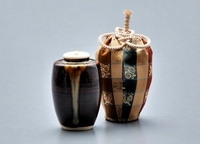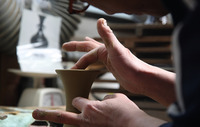

Total:131items
- Pottery & Porcelain (18)
- Koshu Kimen Gawara: Koshu Tile with a Devil’s Face
- Hasami Yaki: Hasami Porcelain
- Kiyomizu Yaki: Kyo style ceramics, Kiyomizu ware
- Otani Yaki: Otani Pottery
- Izushi Yaki: Izushi Porcelain
- Onta-yaki: Onta Pottery
- Takahama Yaki: Takahama Porcelain
- Mushiake- Yaki: Mushiake ware
- Kikuma-Gawara: Kikuma Roof-Tile
- Zeze-Yaki: Zeze ware
- TsutsumiYaki: Tsutsumi Pottery
- Hira Shimizu Yaki: Hira Shimizu Ware
- Tajima Banko Yaki: Tajima Banko Pottery
- Shidoro-Yaki: Shidoro Ware
- Amakusa Tojiki: Amakusa ware
- Shibukusa-yaki: Shibukusa ware
- Karatsu Yaki : Karatsu Ware
- Satsuma-yaki : Satsuma Ware
- Lacquerware (4)
- Glasswork (2)
- Wood & Bamboo Work (19)
- Leather Work (1)
- Papermaking (13)
- Textile (20)
- Dyeing products (5)
- Masonry (1)
- Metal Work (11)
- Stationery (4)
- Livingware (3)
- Accessory (4)
- Toys & Entertainment (14)
- Interior (2)
- Other crafts (10)

 |
Main Production Site:Shiga |
 《Characteristics》
《Characteristics》Zeze ware has been considered to be one of the Enshu Shichiyo, the seven best kilns selected by Enshu Kobori (1579-1647) who was a master of tea ceremony and also a military commander in the early Edo period. His favorite teaware was fired in these seven kilns under his supervision.
It is characterized by its extreme thinness and lightness. Its Mizu-Hiki technique (molding with rokuro, a potter's wheel, using a little water), which make them possible, would be especially valuable. The majority of products are for tea ceremony, and we can see many excellent works among Cha-ire (tea caddy) and Mizusashi (pot to hold the water during tea ceremony).
Early works were made for the gifts among Daimyo (feudal lords). Many of them were made by skilled craftsmen using excellent materials. Tea caddies inscribed with Ooe or Haku-un, both of which are Enshu's favorite styles, are found among Cyuko-Meibutsu, highly valued tools for tea ceremony.
In the next stage, under the patronage of the domain lord, its production was barely continued. In Tenmei period (1781-1789), Ihei Odawara created Bairin ware inspired by Chinese Cochin ware style. After that, Suzumegatani ware was also created, however this kiln was abolished due to financial difficulties.
In Taisho Period (20C), there was a movement to re-establish Zeze ware technique, which continues until today.
A recent research reveals that there was a preceding pottery called Seta ware, which was followed by Zeze ware made at Kokubun kiln and Ooe kiln. Together with these two potteries, Bairin ware and Suzumegatani ware created in the last days of Tokugawa shogunate, as well as "revival" Zeze ware in the Taisho period (1919), are collectively called Zeze ware.
[Traditional Craft Designated by Shiga prefectural governor]
Provided by Zeze ware museum
Translated by: Hiromi Fujii

| Materials | Potter's clay |
|---|---|
| Crafting Processes | 1. Elutriation
Roots and fallen leaves of plants are removed from clay. The clay is soaked in the water and put through a sieve to remove impurities. 2. Desiccation The water is removed from the clay. 3. Kneading Dried clay is kneaded by hand. This work is called Tsuchi neri (Kneading clay). 4.Molding Kneaded clay is molded by hand with a potter's wheel. 5. Painting The unglazed surface is painted first, then glazed. This technique is called Shita-Etsuke; under glazed decoration. 6. Glazing The painted work is glazed. This process makes the surface decorative, adds strength and smoothness and prevent water absorption. 7. Burning The glazed work is fired at 1,200-1,250 degrees in the kiln, then finally finished. |
| History | Zeze ware history started from Seta ware, of which the name was found in the documents and tea ceremony records in 1610s or 20s.
In 1780s, during the reign of the feudal lord of Zeze, Tadafusa Ishikawa, remarkable teaware such as tea pots, tea caddies, pitchers were produced at a governmental kiln. However, the government-designated Zeze ware did not last long because he was transferred to another domain. After that, Bairin ware and Suzumegatani ware barely succeeded to it, however its history once stopped in the early Meiji period (19-20c) owing to financial difficulties. In 1919, with the regret for the disappearance of this distinguished kiln, a Zeze local Kenzo Iwasaki, together with a painter Syunkyo Yamamoto, decided to stake their lives for the re-establishment of Zeze ware. Thanks to their efforts, the kiln was stably managed and the quality of its products became as high as it used to be. Today, it is renowned in the tea culture as well as in the pottery. |
| Related URL | https://zezeyaki.or.jp/ |
◆Exhibition / Showcase
Zeze ware museum
1-22-28 Nakashou Otus city,
Shiga prefecture,
520-0837
Telephone & Fax: +81(0)77-523-1118 (Japanese only)
Opening Hours: AM10:00 - PM16:00
Admission Fee: Adult: 700 yen / Student(aged under 15): 500 yen
Group (Over 30 people): 600 yen
Closed: Monday (Excepted national holiday) ※28th Dec.-7th Jan. is closed.
Assistance needed? For inquiries in English:
JTCO Contact Form
Your inquiries will be forwarded by JTCO in Japanese to the organization you wish to contact.



